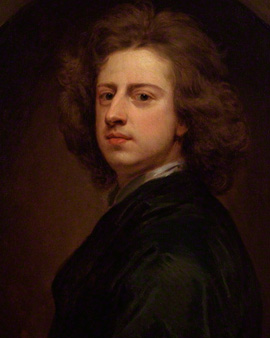Godfrey Kneller was born as Gottfried Kniller, the third son of the painter Zacharias Kniller. The family was wealthy and respected. His father had been in the service of the Swedish king for a long time and had then been appointed to the position of Chief Surveyor in Lübeck. Although his father planned a career in the military for him and therefore sent him to study at the University of Leiden, the young Gottfried's artistic interests prevailed. He moved to Amsterdam, where he was taught by Ferdinand Bol in the style of Rembrandt and also undertook trips to Rome and Venice for study purposes.
From 1666 he worked as an independent painter and moved from Hamburg to England in 1676, where he took his English name. From the year 1700 Kneller counts among the most influential portrait painters. His outstanding ability to produce expressive character studies made him one of the most successful English painters of his time. The entire English, French and German nobility had their portraits painted by him. From 1680 he became the official portraitist of the British king and in 1692 he was elevated to knighthood by the king.
Among his most famous works are the 42 portraits of the members of the important "Kit-Kat-Club" of the English Whigs, which included John Locke. These portraits also gave rise to the term "Kit-Kat-Format" for portraits of a certain, shortened format of about 91 x 71 centimetres, on which at least one hand of the person depicted is always visible.
×





 1702 - (MeisterDrucke-273368).jpg)
 1702 - (MeisterDrucke-273368).jpg)
 1st Duke of Marlborough - (MeisterDrucke-52771).jpg)
 1st Duke of Marlborough - (MeisterDrucke-52771).jpg)
.jpg)
.jpg)
.jpg)
.jpg)
.jpg)
.jpg)
_English_mathematician_physicist_and_astrono_-_(MeisterDrucke-1103903).jpg)
_English_mathematician_physicist_and_astrono_-_(MeisterDrucke-1103903).jpg)
.jpg)
.jpg)
.jpg)
.jpg)
.jpg)
.jpg)
_from_Illustrations_of_English_and_Scottish_History_Volum_-_(MeisterDrucke-100547).jpg)
_from_Illustrations_of_English_and_Scottish_History_Volum_-_(MeisterDrucke-100547).jpg)
.jpg)
.jpg)
 1711 - (MeisterDrucke-67241).jpg)
 1711 - (MeisterDrucke-67241).jpg)
_-_(MeisterDrucke-1636617).jpg)
_-_(MeisterDrucke-1636617).jpg)
_-_(MeisterDrucke-238300).jpg)
_-_(MeisterDrucke-238300).jpg)
_in_the_robes_of_the_Order_-_(MeisterDrucke-1028672).jpg)
_in_the_robes_of_the_Order_-_(MeisterDrucke-1028672).jpg)
.jpg)
.jpg)
 1687 - (MeisterDrucke-195734).jpg)
 1687 - (MeisterDrucke-195734).jpg)
.jpg)
.jpg)
.jpg)
.jpg)
.jpg)
.jpg)
 1711 - (MeisterDrucke-107544).jpg)
 1711 - (MeisterDrucke-107544).jpg)
 1721 - (MeisterDrucke-148319).jpg)
 1721 - (MeisterDrucke-148319).jpg)
 - (MeisterDrucke-145949).jpg)
 - (MeisterDrucke-145949).jpg)
.jpg)
.jpg)
 (see also 194650) - (MeisterDrucke-164644).jpg)
 (see also 194650) - (MeisterDrucke-164644).jpg)
.jpg)
.jpg)
 Austrian military commander in Spain during the War of The Spanish Succession - (MeisterDrucke-76815).jpg)
 Austrian military commander in Spain during the War of The Spanish Succession - (MeisterDrucke-76815).jpg)
.jpg)
.jpg)
.jpg)
.jpg)
.jpg)
.jpg)
.jpg)
.jpg)
 - (MeisterDrucke-115758).jpg)
 - (MeisterDrucke-115758).jpg)
_in_his_coronation_robes_1727_-_(MeisterDrucke-255577).jpg)
_in_his_coronation_robes_1727_-_(MeisterDrucke-255577).jpg)
.jpg)
.jpg)
 of Orange (see also 194651) - (MeisterDrucke-197335).jpg)
 of Orange (see also 194651) - (MeisterDrucke-197335).jpg)
 second wife of 1 - (MeisterDrucke-278028).jpg)
 second wife of 1 - (MeisterDrucke-278028).jpg)
.jpg)
.jpg)
 engraved by James Posselwhite (1798-1884) pub by William Mackenzie - (MeisterDrucke-208112).jpg)
 engraved by James Posselwhite (1798-1884) pub by William Mackenzie - (MeisterDrucke-208112).jpg)
 - (MeisterDrucke-280380).jpg)
 - (MeisterDrucke-280380).jpg)
 - (MeisterDrucke-161412).jpg)
 - (MeisterDrucke-161412).jpg)
.jpg)
.jpg)
_-_(MeisterDrucke-94883).jpg)
_-_(MeisterDrucke-94883).jpg)
_1690_8Gkilled_at_the_Battle_of_Steenkirk_in_1692_-_(MeisterDrucke-199490).jpg)
_1690_8Gkilled_at_the_Battle_of_Steenkirk_in_1692_-_(MeisterDrucke-199490).jpg)
.jpg)
.jpg)
.jpg)
.jpg)
.jpg)
.jpg)
 second wife of 1 - (MeisterDrucke-284624).jpg)
 second wife of 1 - (MeisterDrucke-284624).jpg)
.jpg)
.jpg)
_c1663-1708_(oil_on_-_(MeisterDrucke-1376644).jpg)
_c1663-1708_(oil_on_-_(MeisterDrucke-1376644).jpg)
 - (MeisterDrucke-65574).jpg)
 - (MeisterDrucke-65574).jpg)
.jpg)
.jpg)
.jpg)
.jpg)
_-_(MeisterDrucke-312970).jpg)
_-_(MeisterDrucke-312970).jpg)
.jpg)
.jpg)
.jpg)
.jpg)
_late_17th_to_early_18th_century_(oil_pai_-_(MeisterDrucke-1501589).jpg)
_late_17th_to_early_18th_century_(oil_pai_-_(MeisterDrucke-1501589).jpg)
_-_(MeisterDrucke-1376589).jpg)
_-_(MeisterDrucke-1376589).jpg)
_(1633-1701)_Painting_by_G_-_(MeisterDrucke-984599).jpg)
_(1633-1701)_Painting_by_G_-_(MeisterDrucke-984599).jpg)
_-_(MeisterDrucke-1457541).jpg)
_-_(MeisterDrucke-1457541).jpg)
.jpg)
.jpg)
.jpg)
.jpg)
.jpg)
.jpg)
.jpg)
.jpg)
.jpg)
.jpg)
.jpg)
.jpg)
.jpg)
.jpg)
_-_(MeisterDrucke-312677).jpg)
_-_(MeisterDrucke-312677).jpg)
.jpg)
.jpg)
.jpg)
.jpg)
_-_(MeisterDrucke-1498808).jpg)
_-_(MeisterDrucke-1498808).jpg)
.jpg)
.jpg)
.jpg)
.jpg)
.jpg)
.jpg)
_-_(MeisterDrucke-1081199).jpg)
_-_(MeisterDrucke-1081199).jpg)
.jpg)
.jpg)
.jpg)
.jpg)
 copied by Edmund Dyer - (MeisterDrucke-214998).jpg)
 copied by Edmund Dyer - (MeisterDrucke-214998).jpg)
.jpg)
.jpg)
.jpg)
.jpg)
 of Orange - (MeisterDrucke-150505).jpg)
 of Orange - (MeisterDrucke-150505).jpg)
.jpg)
.jpg)
.jpg)
.jpg)
.jpg)
.jpg)
_-_(MeisterDrucke-1376609).jpg)
_-_(MeisterDrucke-1376609).jpg)
.jpg)
.jpg)
.jpg)
.jpg)
.jpg)
.jpg)
.jpg)
.jpg)
_-_Portrait_of_George_I_of_Great_-_(MeisterDrucke-941464).jpg)
_-_Portrait_of_George_I_of_Great_-_(MeisterDrucke-941464).jpg)
.jpg)
.jpg)
.jpg)
.jpg)
 - (MeisterDrucke-130606).jpg)
 - (MeisterDrucke-130606).jpg)
 engraved by Richard Cooper - (MeisterDrucke-168752).jpg)
 engraved by Richard Cooper - (MeisterDrucke-168752).jpg)
_c1633-1700_-_(MeisterDrucke-1376583).jpg)
_c1633-1700_-_(MeisterDrucke-1376583).jpg)
.jpg)
.jpg)
.jpg)
.jpg)
.jpg)
.jpg)
.jpg)
.jpg)
.jpg)
.jpg)
.jpg)
.jpg)






